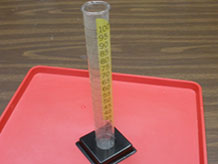What happens when we add earth materials to water?
1. Ask the question

Let students know they have come a long way measuring their earth materials.
- They know how to find the weight of materials using a digital scale.
- They know how to find the volume of liquids using their measuring cups.
- They know how to find the volume of objects by observing how much water they displace.
Today they will get more practice finding volumes using the water displacement method, and they will find the volume of some new earth materials: gravel and sand. They will also learn how to use a new instrument — a graduated cylinder.
Show the class the 50cc graduated cylinder with 40cc of water in it. Explain that scientists use graduated cylinders to measure liquids and solids, much as the students did when they used their "measuring cups" to measure water samples — and when they used the containers to measure the volume of rocks in the last session. Explain that graduated cylinders come with measuring lines already marked on them. Pass around the cylinder.
- What is the unit of measurement?
- How much water is there in the cylinder right now?
Four key understandings:
- Two objects cannot occupy the same space at the same time.
- Objects that are submerged in water will displace water (push it out of the way and take its place) and this raises the water level.
- The more space the submerged object takes up, the higher the water level rises.
- The amount of water displaced by a submerged object is equal to the volume of the object.
Check students' understanding of the relationship between volume and water displacement.
- What do you think will happen to the water level if we put 10 centimeter cubes into this graduated cylinder?
- How much will it rise? What marking will the water reach on the graduated cylinder?
Check students' predictions by dropping 10 cubes into the cylinder.
- What if we dropped in 15 centimeter cubes? 20? What about a rock with a volume of 30 cubic centimeters? How would that affect the water level?
Students will likely propose that the water level will rise to a level that equals the sum of the water volume and the material volume. If not, review the principles in the boxed note.
Call attention to the investigation question:
What happens when we add earth materials to water?



